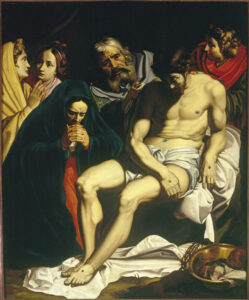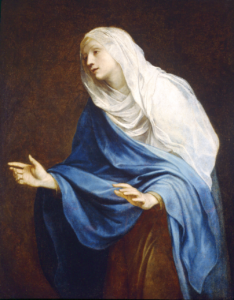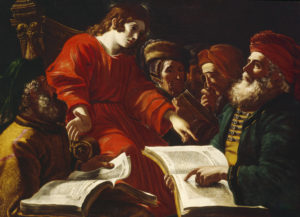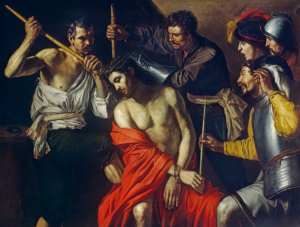Lamentation over the Dead Christ
Oil on panel, c. 1610–12
Abraham Janssens
Flemish, c. 1575–1632
When the word “baroque” is mentioned, there are two names that people associate with this art history movement—Italian artist Michelangelo Merisi da Caravaggio and Flemish artist Peter Paul Rubens. Both artists dominated Europe with their dramatic scenes, rich colors, chiaroscuro, accomplishments, and larger-than-life personalities. In the shadow of these masters and their artistic masterpieces, other artists have done their best to imitate or infuse their own style with these titans’ techniques. One such artist is fellow countryman to Rubens, Abraham Janssens.
Janssens’s work had impressive range. Throughout his career, his subject matter included biblical, historical, and allegorical scenes as well as occasional portraits. His stylistic changes are perhaps the most interesting. The first paintings of his oeuvre would be labeled Flemish Mannerist. Then after a trip to Italy in the early 1600s, he began to adopt a more Caravaggesque approach. Finally, his work became more Rubenesque after Rubens returned home and began to command the Flemish art scene. Janssens’s shift in his different styles can be seen in one specific subject matter—the Lamentation of Christ.
The Lamentation of Christ is an extra-biblical subject that portrayed groups of people mourning around the dead Christ. As mentioned in the gospels (Matthew 27:59-61, Mark 15:46-47, Luke 23:53-56, and John 19:38-42), this group usually included His mother, Mary, and various others. It is the perfect subject matter to compare Janssens’s stylistic shift since it shows strong emotion, sculptural figures, and a dramatic biblical narrative.
First, is Janssens’s Lamentation of Christ painted between 1600 and 1604. This work shows typical Mannerist characteristics with its bright colors and elongated figures. There is emotion, but it is not the intense drama of the Baroque. Since Janssens was in Rome from 1598-1601, it is interesting to note that he did not immediately adopt Caravaggio’s style. According to 17th-century Dutch painting scholar, Justus Müller Hofstede, most of Caravaggio’s early innovations in Italian painting (ca. 1593-1598) such as half-figure compositions, still-life painting, and secularization of religious themes were already in use in Antwerp. Hofstede concludes that Caravaggio’s early pioneer work wouldn’t have impressed Janssens.
It wasn’t until 1607 that Janssens began incorporating Caravaggio’s technique. This style is wonderfully shown in the Museum & Gallery’s Lamentation Over the Dead Christ, painted between 1610-1612. There is a marked stylistic shift to baroque characteristics compared to the first Lamentation. There is a sculptural, monumental quality to his figures, which would become a trademark of Janssen’s career. The lighting is harsh and dramatic and reminiscent of Caravaggio’s best works. This Lamentation also shows an extreme depth of sorrow. The furrowed, anguished brow on Mary is a contrast to the first Lamentation’s rather passive Mary.
Finally, Janssens began adapting to a Rubenesque approach. His later The Lamentation over the Dead Christ painted in 1621-22 includes similar elements from M&G’s Caravaggesque example. However, it does not have the same harshness or extreme sorrow. You can see Rubens’s influence in the rich coloring and more dramatic movement throughout the composition. Janssens still maintains his trademark stiffness and sculptural feel to his figures. According to historian Irene Schaudies, it is Janssens’s focus on his figures looking like classical statues rather than painting from empirical observation like Caravaggio and Rubens that kept Janssens in their shadow. Nevertheless, by looking at these three paintings, one can appreciate what a master Janssens was with his different stylistic portrayals of one of the most emotive scenes in Scripture.
KC Christmas Beach, M&G summer art educator
Published 2025



